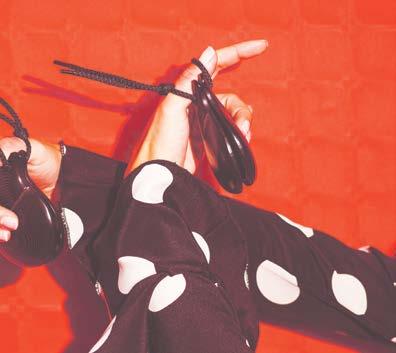
2 minute read
ALL THE fun
strung in loops over elaborate arches like necklaces of dazzling jewels.

It’s a temporary town for the week, with 175 casetas (a superior alternative to hospitality tents), each hosted by a religious association or a winery, a business, or a social group –all of whom go all out with the decor, adding potted palms, terraces, window boxes, elaborate facades, and painted wooden chairs. Most casetas (unlike Sevilla, as said) are open to the public, and most will be serving food at some point. If not a guest of the aristocracy at a private catered feast, your choices are mainly limited to fried fish, calamares and papas aliñas on paper plates, but there’s also fabulous jamon and you can’t go wrong with that – unless you’re a vegetarian. Each caseta has a bar where you can buy drinks, specifically Jerez sherry and rebujitos (sherry and lemonade), the feria classic down in these parts. And all are guaranteed to have music playing loudly and, at what seems random times, live flamenco. Catching a performance here, among an audience of well-fuelled, passionate aficionados, is an unforgettable experience. This year’s event is dedicated to flamenco fashion (a thriving creative industry) and the magnificent Lola Flores who was born in Jerez 100 years ago. The singer, dancer and star of the silver screen was what amounts to a national treasure and you will, for sure, be hearing multiple renditions of her greatest hit, Ay Pena, Penita, Pena The week starts fairly sedately (there are discounts for pensioners on the Monday), and builds to a grand finale with the biggest shows on Friday and Saturday. Choose which day cording to erance for sion and queues, but
By Sorrel Downer
time it to coincide with the last hours of the Paseo de Jinetes y Caballos (held Monday-Saturday, 1pm-7.30pm) when hundreds of horses, riders, and carriage drivers circle the fairground, nodding to people before dusk and the lights go on.
Note: the opening hours are 1pm to dawn, Andalucia style. There is a lot of horse action, much of it competitive and taking place in the Equisur area. Try to catch the displays of doma vaquera, a unique form of dressage rooted in cattle herding and wrangling out in the sierras, and involving fancy footwork on the part of the horse. At the far end from the main entrance, there are fairground rides – a blindingly hot expanse of roaring generators and over excited children buying plastic things. Not for nothing is it called the Calle del Infierno (Street of Hell).
It’s not only the horses that parade around impeccable and proud to murmurs of admiration: the at tendees do too: Peo ple come beau tifully dressed – the women with flowers in their hair and stitched into full length dresses of vi brant hue and trailing flounc es, and men in the traditional short jacketed suits in grey and blue with boater style hats. You can expect to see some im pressive bandalero style sideburns, too. It would be tempting to dress like that – but just don’t.
Etiquette
The Feria de Jerez is officially designated as being of international tourism interest, and hundreds of tourists visit each year and are warmly received, but there is an unspoken code of etiquette.

If you are a foreigner, unless going with friends from Jerez who absolutely demand you must, it’s not advisable to attempt wearing a full flamenco traje (outfit). Firstly, it’s hard to carry off; and secondly, flamenco dress is by no means a costume, but an extension of deep-rooted, local culture. In Jerez – ferias –you are welcome to squeeze into the casetas, and buy drinks and food at the bar. But don’t head to the best table – the casetas are there to enable the hosts to offer hospitality to their own family, friends and clients.

However much you enjoy the singing, don’t feel the need to join in, although the occasional, well-timed ole! may go down well.





